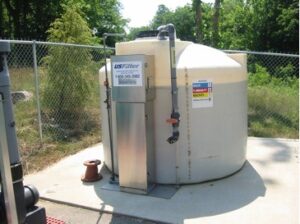Nitrates for Odor Control: When and Why They Work Best in Wastewater Systems
 Odor issues are a common challenge for wastewater utilities and industrial plants. Hydrogen sulfide (H₂S) is often the main culprit, causing both unpleasant smells and corrosion problems. Chemical treatment remains one of the most effective tools for managing these conditions. One of the most widely used chemicals is nitrate, which has been a reliable option for many years.
Odor issues are a common challenge for wastewater utilities and industrial plants. Hydrogen sulfide (H₂S) is often the main culprit, causing both unpleasant smells and corrosion problems. Chemical treatment remains one of the most effective tools for managing these conditions. One of the most widely used chemicals is nitrate, which has been a reliable option for many years.
At Webster Environmental Associates (WEA), we help facilities decide when nitrates for odor control are the right choice. We also guide them on how to integrate nitrate use into a broader odor management strategy.
How Nitrates for Odor Control Work
Nitrates target odor at the source by altering the natural biological process that generates hydrogen sulfide. In untreated wastewater, bacteria often shift into sulfate reduction when oxygen is low. This process produces H₂S gas, which causes odor and corrodes equipment.
When nitrates are introduced, bacteria use nitrate as their oxygen source instead of sulfate. This change suppresses sulfide generation and reduces odor before it becomes a problem.
Nitrate is typically injected into force mains, wet wells, or other upstream points where wastewater is likely to become anaerobic. By stopping hydrogen sulfide from forming, the system prevents odor and corrosion further downstream.
When Nitrates Are the Best Fit
Nitrates work best in systems with predictable flow conditions and steady sulfide loads. They are especially effective in force mains with long retention times, where wastewater is most likely to become anaerobic.
They are also a good option for facilities that need a quick, reliable solution. Because nitrates act biologically, they start reducing sulfide production shortly after dosing. This makes them valuable in systems where odor complaints are already a problem.
Other treatment methods, such as iron salts or oxygen injection, may be less effective in certain situations. Iron salts work well but often create more solids, while oxygen injection requires equipment that may not be feasible in remote locations. Nitrates offer a flexible, fast-to-deploy alternative in these cases.
Comparing Nitrates to Other Approaches
 Each chemical treatment method has its strengths and weaknesses. Nitrates offer consistent results in systems with predictable flow and steady sulfide production. They also reduce corrosion and can be easier to manage in smaller facilities.
Each chemical treatment method has its strengths and weaknesses. Nitrates offer consistent results in systems with predictable flow and steady sulfide production. They also reduce corrosion and can be easier to manage in smaller facilities.
However, nitrates may have higher chemical costs over time than other options. Overdosing can also lead to downstream impacts, such as increased nutrient loads. That is why it is critical to design and operate nitrate feed systems carefully.
Iron salts are effective for binding sulfides but can add to sludge production. Magnesium hydroxide works well in plants where pH control is also needed, but it does not act as quickly as nitrates. Oxygen injection is cost-effective in some applications but requires a dependable power source and more complex equipment.
At WEA, we evaluate each site individually before recommending a strategy. Sometimes nitrates alone are the right answer. In other cases, we combine nitrate feed with another technology to meet long-term odor control goals.
How WEA Designs and Supports Nitrate Feed Systems
The key to success with nitrates for odor control is accurate dosing and system design. WEA starts with a site evaluation that includes air and liquid sampling. This data shows where sulfide is forming and how much nitrate is needed to suppress it.
From there, we design a chemical feed system that fits the site. This includes selecting the right storage tanks, pumps, and monitoring equipment. Our systems are built with flexibility in mind so operators can adjust dosing as conditions change.
WEA also provides startup support and operator training. We teach staff how to handle nitrates safely and how to track system performance. Once the system is running, we offer follow-up monitoring and adjustments to improve efficiency and reduce chemical costs over time.
Our experience working with utilities and industrial plants means we understand how these systems operate in the real world. We focus on practical solutions that work in daily operations, not just on paper.
Partner with WEA for Smarter Chemical Treatment
Odor control is critical for protecting infrastructure, staying in compliance, and maintaining good relationships with the community. Nitrates are a proven tool for managing hydrogen sulfide, but they need to be used correctly to be effective and cost-efficient.
If you are considering nitrates for odor control or want to review your current program, WEA can help. We provide testing, system design, and ongoing support to help you reduce odors and protect your collection system.
Contact Webster Environmental Associates today to schedule a site assessment or chemical feed system review. Our team will help you decide if nitrates are the right fit and design a program that works for your facility.
